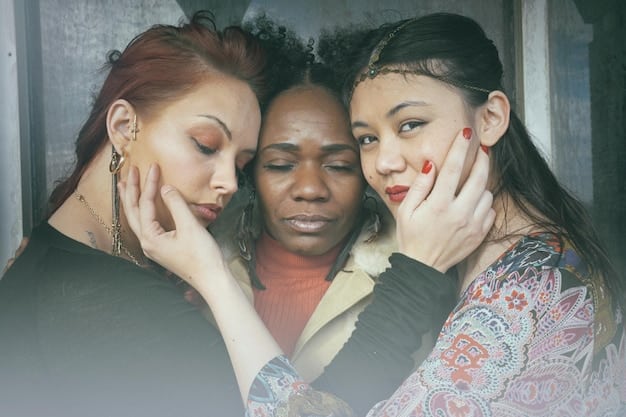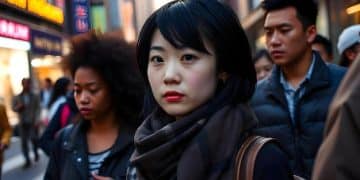The Evolution of Female Leads in J-Dramas: A Captivating Look

The Evolution of Female Leads in J-Dramas: A Look at the inspiring shift in Japanese drama, from demure characters to strong, independent women who drive narratives and defy conventional expectations, reflecting broader societal changes.
Japanese dramas, or J-dramas, have long captivated audiences with their unique storytelling and compelling characters. One of the most significant shifts in recent years has been the evolution of female leads in J-Dramas: A Look at how these characters have transformed from passive figures to powerful, independent women who drive the narrative.
The Early Years: Traditional Roles and Archetypes
In the early days of J-dramas, female characters often adhered to traditional Japanese societal expectations. These women were typically portrayed as demure, obedient, and primarily focused on domestic duties or romantic relationships. Their storylines often revolved around finding a husband or supporting the male lead’s ambitions.
The Yamato Nadeshiko Ideal
The “Yamato Nadeshiko” ideal, representing the perfect Japanese woman, heavily influenced these early portrayals. This archetype emphasized qualities like grace, humility, and self-sacrifice. Female characters were often depicted as caregivers, prioritizing the needs of their families and partners above their own aspirations.
These early J-dramas reflected the prevailing social norms, where women’s roles were largely confined to the domestic sphere. While these characters were often endearing and sympathetic, they lacked the agency and complexity seen in later female leads.

The Rise of Working Women: Career-Oriented Characters
As Japan’s economy grew and more women entered the workforce, J-dramas began to reflect this shift. Female characters started taking on professional roles, challenging traditional expectations and pursuing their own careers. These dramas often explored the challenges women faced in balancing work and family life.
Breaking Barriers in the Workplace
Dramas featuring career-oriented female leads highlighted the obstacles women encountered in male-dominated industries. These characters had to overcome societal biases, prove their competence, and navigate workplace politics. Their storylines often revolved around their professional achievements, personal growth, and the struggle to be taken seriously.
- Balancing career aspirations with societal expectations.
- Overcoming gender discrimination in the workplace.
- Finding fulfillment and independence through work.
- Navigating the challenges of being a working mother.
This era marked a significant departure from the traditional portrayals of women in J-dramas. It celebrated female ambition, intelligence, and the pursuit of personal and professional fulfillment.
Independent Women: Taking Control of Their Destinies
In recent years, J-dramas have embraced female leads who are fiercely independent, self-reliant, and in control of their own destinies. These characters are not defined by their relationships with men or their family responsibilities. They are complex individuals with their own goals, desires, and flaws.
Challenging Gender Norms
These dramas often tackle social issues such as gender inequality, sexual harassment, and the pressure on women to conform to societal expectations. The female leads challenge these norms, advocating for their rights and inspiring viewers to question traditional roles. They prove that women can be strong, independent, and successful without sacrificing their individuality.
By showcasing these independent women, J-dramas empower viewers to challenge traditional gender roles and embrace their own unique identities.
Diversity in Representation: Beyond Stereotypes
Another significant development is the increasing diversity in the representation of female leads. J-dramas are moving beyond stereotypical portrayals and showcasing women from different backgrounds, ethnicities, and sexual orientations. This inclusivity allows for a richer and more authentic exploration of the female experience.

Exploring LGBTQ+ Themes
Some J-dramas are now featuring LGBTQ+ female characters, exploring themes of same-sex relationships, gender identity, and the challenges faced by the LGBTQ+ community. These dramas promote acceptance, understanding, and empathy, contributing to a more inclusive and diverse media landscape.
- Breaking down LGBTQ+ stereotypes in media.
- Promoting inclusivity and acceptance of diverse identities.
- Offering representation for marginalized communities.
- Sparking conversations about social justice and equality.
This move towards greater diversity in representation is a positive step, making J-dramas more relatable and relevant to a wider audience.
Strong Female Friendships: Sisterhood and Support
J-dramas are increasingly highlighting the importance of female friendships, showcasing the bonds of sisterhood and the power of female support. These dramas often feature groups of women who rely on each other for emotional support, career advice, and navigating life’s challenges. These friendships are portrayed as essential for personal growth and well-being.
The Power of Female Bonds
These portrayals emphasize the importance of women supporting women, creating a sense of community and solidarity. By showcasing strong female friendships, J-dramas demonstrate the strength and resilience that can be found in female bonds, challenging the notion that women are inherently competitive or catty.
These dramas celebrate the power of female friendships and encourage viewers to cultivate their own supportive relationships with other women.
Future Trends: Continued Empowerment and Innovation
The evolution of female leads in J-dramas shows no signs of slowing down. Future trends suggest a continued focus on empowerment, innovation, and pushing boundaries. We can expect to see even more complex, nuanced, and diverse female characters who challenge societal expectations and inspire viewers around the world. Exploring themes of mental health, social activism, and personal reinvention could be some of the areas that J-dramas tackle in the future, potentially leading to even more captivating and socially conscious storytelling.
Global Impact and Influence
As J-dramas gain popularity internationally, their portrayal of female leads has the potential to influence audiences worldwide. These dramas can challenge traditional gender roles, promote female empowerment, and foster a more inclusive and equitable society. The continued evolution of female leads in J-dramas is not only a reflection of societal changes in Japan but also a powerful force for positive change globally.
By continuing to create compelling and empowering female characters, J-dramas can inspire viewers to challenge traditional norms, embrace their individuality, and pursue their dreams.
| Key Point | Brief Description |
|---|---|
| 🎭 Traditional Archetypes | Early female characters often adhered to traditional roles. |
| 💼 Working Women Rise | More female leads became career-oriented, breaking barriers. |
| 💪 Independence Era | Strong, independent women take control of their destinies. |
| 👭 Female Friendships | Emphasis on sisterhood and the power of female support. |
Frequently Asked Questions
▼
Early J-dramas often depicted female leads in traditional, demure roles, primarily focused on domestic duties, supporting male leads, or finding a husband, reflecting conventional societal expectations.
▼
As more women entered the workforce in Japan, J-dramas began to feature career-oriented female characters who faced challenges in male-dominated industries, balancing work and personal life.
▼
Modern J-dramas showcase fiercely independent female characters who are not defined by their relationships, possess their own goals, and challenge societal norms and gender inequalities.
▼
Diversity in J-dramas has expanded to include women from various backgrounds, ethnicities, and sexual orientations, allowing for a richer exploration of different female experiences and LGBTQ+ themes.
▼
J-dramas highlight female friendships as essential for emotional support and personal growth, challenging notions that women are inherently competitive and promoting solidarity among women.
Conclusion
The trajectory of female leads in J-dramas mirrors evolving societal norms, illustrating a shift from conventional roles to portrayals of dynamic and empowered women. This evolution provides compelling narratives and mirrors a global trend of increased appreciation for diverse female stories and experiences.





